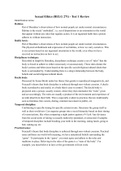Summary
Summary RELG 371 - Review for Test 1
- Course
- RELG 271 (RELG271)
- Institution
- McGill University (Mcgillu)
Summary of key terms with definitions for the first module of the term. The test will ask you to describe several terms based on class notes and readings. All possible terms and concepts are listed here. Sexual Ethics is largely about understanding concepts, so this is a great starting point if you...
[Show more]



